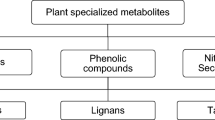Abstract
Phanerochaete chrysosporium uses hydrogen peroxide as a substrate in its ligninolytic phase. To determine how the fungus protects itself against detrimental effects of reactive oxygen species, catalase activity was examined. The fungus produced up to four different catalase isozymes, Cat A to D. Isozyme CatC was the dominant activity in all growth conditions. A minor catalase, CatD, was apparent in low-carbon culture and upon exposure of mycelium grown on high-nitrogen medium with 5–50 mm of hydrogen peroxide. In low-nitrogen culture, an increase in catalase-specific activity preceded the onset of ligninolysis by 3 days. In low-carbon culture, catalase was produced at an even higher level without development of ligninolysis. Thus, catalase activity was not coordinately produced with ligninolytic metabolism.
Similar content being viewed by others
Author information
Authors and Affiliations
Additional information
Received: 23 May 2000 / Accepted: 21 July 2000
Rights and permissions
About this article
Cite this article
Kwon, SI., Anderson, A. Catalase Activities of Phanerochaete chrysosporium Are Not Coordinately Produced with Ligninolytic Metabolism: Catalases from a White-Rot Fungus. Curr Microbiol 42, 8–11 (2001). https://doi.org/10.1007/s002840010169
Issue Date:
DOI: https://doi.org/10.1007/s002840010169




